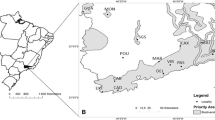Abstract
Mapping species richness and distributions is an important aspect of conservation and land use planning, but the time and cost of producing maps from field surveys is prohibitive. It is useful, therefore, if mappable environmental variables, from a readily accessible source, can be used as surrogates for species attributes. We evaluated the power of satellite-derived land cover information, from the Land Cover Map of Great Britain, to predict species richness and occurrences of terrestrial mammals in one hundred 10×10 km quadrats, from four regions of Britain. The predictive power of the land cover data was relatively poor – with a few exceptions, land cover explained less than half of the variation in mammal species richness and occurrence in regression models. Predictive power was considerably stronger when regions were analyzed separately than when analyzed together, and best fitting models varied between regions and between mammal taxa. Predictive power was also affected (positively or negatively depending on taxon) when PCA-ordinated land cover variables were used as predictors. The predictive strength of the land cover data was probably limited mostly by the high proportion of British mammal species with geographic distributions changing rapidly and independently of land cover (and hence the non-saturation of preferred habitats), and to a lesser extent by shortcomings in the mammal and land cover data, and the influence of landscape factors other than land cover on mammal distributions. The results suggest that regional stratification is essential when attempting to predict species richness and distributions, even across relatively limited areas such as Great Britain. We conclude that caution is necessary in using results from environmental information systems such as this as a basis for conservation and land use planning decisions.
Similar content being viewed by others
References
Adams, J. A. 1996. Towards a better vegetation scheme for global mapping and monitoring. Global Ecol. Biogeogr. Lett. 5: 3–6.
Arnold, H. 1993. The Atlas of British mammals. Institute of Terrestrial Ecology and Joint Nature Conservation Committee, U.K.
Bian, L. 1997. Multiscale nature of spatial data in scaling up environmental models. In Scale in remote sensing and GIS. pp. 13–26. Edited by D. A. Quattrochi and M. F. Goodchild. CRC Press, Boca Raton.
Bohning-Gaese, K. 1996. Determinants of avian species richness at different spatial scales. J. Biogeogr. 24: 49–60.
Bright, P. W., Mitchell, P. and Morris, P. A. 1994. Dormouse distribution: survey techniques, insular ecology and selection of sites for conservation. J. Appl. Ecol. 31: 329–339.
Butterfield, B. R., Csuti, B. and Scott, J. M. 1994. Modeling vertebrate distributions for Gap Analysis. In Mapping the diversity of nature. pp. 53–68. Edited by R. I. Miller. Chapman and Hall, London.
Clarke, R. (ed.) 1986. The handbook of ecological monitoring. Clarendon Press, Oxford.
Corbet, G. B. and Harris, S. (eds.) 1991. The handbook of British mammals. Blackwell Scientific Publications, Oxford.
Danell, K., Lundberg, P. and Niemela, P. 1996. Species richness in mammalian herbivores: patterns in the boreal zone. Ecography 19: 404–409.
DETR 1998. CIS World Wide Web site: http://www.nmw.ac.uk/ite/cisflier.html.
Fuller, R. M., Groom, G. B. and Jones, A. R. 1994. The Land Cover Map of Great Britain: An automated classification of Landsat Thematic Mapper data. Photogram. Engng. Remote Sensing 60: 553–562.
Gurnell, J. and Pepper, H. 1993. A critical look at conserving the British red squirrel Sciurus vulgaris. Mammal Rev. 23: 127–137.
Harris, S., Morris, P., Wray, S. and Yalden, D. 1995. A review of British mammals: population estimates and conservation status of British mammals other than cetaceans. Joint Nature Conservation Council, Peterborough.
Macdonald, D. W., Mace, G. M. and Rushton, S. P. 1998. Proposals for future monitoring of British mammals. Mammal monitoring: a plan for the 21st century. Department of Environment, Transport and the Regions and Joint Nature Conservation Council, U.K.
Macdonald, D. W., Mitchelmore, F. and Bacon, P. J. 1996. Predicting badger sett numbers: evaluating methods in East Sussex. J. Biogeog. 23: 649–655.
Miller, R. I. (ed.) 1994. Mapping the diversity of nature. Chapman and Hall, London.
Short, H. Z., Hestbeck, J. B. and Tiner, R. W. 1996. Ecosearch: a new paradigm for evaluating the utility of wildlife habitat. In Conservation of faunal diversity in forested landscapes. pp. 569–594. Edited by R.M. DeGraaf and R. I. Miller. Chapman & Hall, London.
Spellerberg, I. F. 1991. Monitoring ecological change. Cambridge Univ. Press, Cambridge.
Thornton, P. S. 1988. Density and distribution of badgers in southwest England – a predictive model. Mammal Rev. 18: 11–23.
Turner, M. G., O'Neill, R. V., Gardner, R. H. and Milner, B. T. 1989. Effects of changing spatial scale on the analysis of landscape pattern. Landscape Ecol. 3: 153–162.
Turpie, J. K. and Crowe, T. M. 1994. Patterns of distribution, diversity and endemism of larger African mammals. S. Afr. J. Zool. 29: 19–31.
Veitch, N., Treweek, J. R. and Fuller, R. M. 1995. The Land Cover Map of Great Britain – A new data source for environmental planning and management. In Advances in environmental remote sensing. pp. 157–170. Edited by F. M. Danson and S. E. Plummer. John Wiley and Sons, Chichester.
Wright, D. H., Currie, D. J. and Maurer, B. A. 1993. Energy supply and patterns of species richness on local and regional scales. In Species diversity in ecological communities: historical and geographical perspectives. pp. 66–74. Edited by R. E. Ricklefs and D. Schluter. University of Chicago Press, Chicago.
Author information
Authors and Affiliations
Rights and permissions
About this article
Cite this article
Cardillo, M., Macdonald, D.W. & Rushton, S.P. Predicting mammal species richness and distributions: testing the effectiveness of satellite-derived land cover data. Landscape Ecology 14, 423–435 (1999). https://doi.org/10.1023/A:1008088224783
Issue Date:
DOI: https://doi.org/10.1023/A:1008088224783




